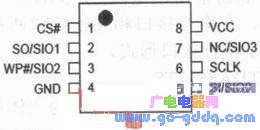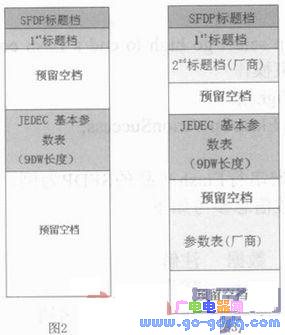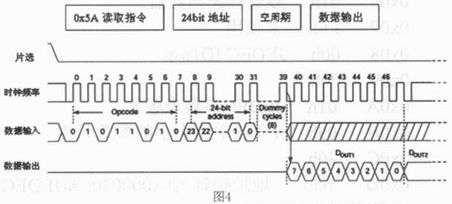The JEDEC standard (JESD216) Serial Flash Discoverable Parameter (SFDP) [1] is a parameter table that describes the functions of serial flash memory, which can be queried directly from the device. This article provides an in-depth explanation of the structure, purpose, and practical application of this parameter table in system design. It highlights how SFDP simplifies the integration of serial flash into various systems by providing standardized access to critical device information. Serial Flash is a type of SPI interface NOR Flash, a non-volatile memory used primarily to store boot code for a system. Its advantages include compact size, minimal pin count, simple interface, and ease of expansion. The typical package has 8 pins, including chip select, data input, write protection, ground, data output, clock, pause, and voltage. Compared to parallel flash, serial flash uses a one-input-one-output data transmission method, reducing the number of data, address, and control lines. Some advanced models support four-in-four-out modes, significantly increasing data transfer rates. Current maximum frequencies exceed 104MHz, making serial flash faster than many parallel flash solutions. With the right main chip support, serial flash can replace parallel flash in certain applications, reducing PCB size, wiring complexity, and improving electromagnetic compatibility. From a system design perspective, using serial flash instead of parallel flash reduces the number of storage port pins, which helps shrink the main chip’s area and improve overall design efficiency. As a result, serial flash is increasingly popular among developers and engineers, finding wide use in computers, consumer electronics, wireless communications, automotive, and industrial control systems.

With the growing demand for serial flash in the market, the variety of commands, features, and functionalities across different manufacturers has increased. This leads to inconsistencies in erase operations, instruction sets, and functional definitions between devices. To ensure compatibility during system testing or upgrades, designers must carefully review each manufacturer's specifications, which can be time-consuming and complex. This process often requires modifying driver software or even hardware, creating challenges in design, maintenance, and updates. Therefore, there is a strong need for a unified function parameter table that allows developers to quickly access and understand the capabilities of any serial flash device. This need gave rise to the JESD216 SFDP standard, developed by JEDEC to provide a consistent and reliable way to query serial flash information.

The JESD216 SFDP standard, currently at version 1.0, defines a standardized function parameter table embedded within serial flash devices. This table does not consume any of the device’s normal storage capacity. SFDP supports read frequencies up to 50MHz, although serial flash itself may operate at higher speeds. The standard also supports flexible data transmission modes, including single, dual, and quad input/output, making it adaptable to different system requirements. Once factory-programmed, SFDP data is fixed and cannot be modified. Its role is similar to the Common Flash Interface (CFI) used in parallel flash, allowing developers to quickly retrieve key device information such as vendor ID, device parameters, and supported instructions through a specific command (0x5A). This improves device recognition, communication efficiency, and software compatibility, enabling more efficient system design and debugging. The SFDP standard mandates the inclusion of a header file, a first parameter header, and a basic JEDEC Flash parameter table. The header contains a signature (0x50444653), which confirms that the device supports the SFDP standard. The basic parameter table includes essential details like reading methods, instruction sets, sector sizes, and chip capacities. Manufacturers can also add additional parameter headers and tables to expand device-specific features, such as voltage ranges, special commands, and optional functions. These extensions are not required by the SFDP standard but can enhance device identification and usability.

To read SFDP data, the system software must follow a specific sequence: activate the chip select signal, send the 0x5A instruction to initiate the SFDP read, then send a 3-byte address and a dummy cycle before reading the data from the output pin. The timing diagram for this process is shown in the figure above. Proper implementation of these steps ensures accurate and reliable access to the SFDP parameter table, allowing the system to dynamically adapt to different serial flash devices without manual configuration. This feature makes SFDP a powerful tool for simplifying system design, enhancing compatibility, and accelerating development cycles in modern embedded systems.
Surface Mount Assembly,print circuit board assembly,Smt Assembly Pcba,smt pcba board
Dongguan Jinglin Communication Technology Co., Ltd. , https://www.jlpcba.com